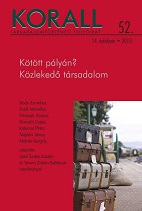A vasút Ferencvárosban. Egy nagyvárosi ipari zóna térszerkezeti vizsgálata
The Railway in Ferencváros: Spatial Analysis of a Metropolitan Industrial Zone
Author(s): Veronika EszikSubject(s): History
Published by: KORALL Társadalomtörténeti Egyesület
Summary/Abstract: To this day, Central Europe’s biggest rail hub is the Budapest-Ferencváros Railway Station, which was first opened in 1877. While there has been much socio-historical research conducted into the social impact of important passenger stations, the history of the rail lines connecting Budapest stations and the construction of the Ferencváros railway station has remained unexplored. The study briefly discusses the background and history of the station’s construction and goes on to explain the consequences of this development: the main focus is on the radical changes that the station brought to the urban district of Ferencváros and the first Hungarian metropolitan industrial zone as social space. The effects of the railway on Ferencváros as a social space were ambiguous. On one hand, conscious town planning and well-developed infrastructure, as well as the district’s unusual proportions and busy industrial plants, created a hitherto unknown atmosphere of modernity. On the other hand, the railway has also contributed to the solidification of problematic characteristics, such as isolation and peripherality. The connecting rail line had an important role in the country’s internal trade. However, while the station connected Ferencváros to the national bloodstream, in reality this meant the district’s ultimate segregation within the gradually integrating Budapest space. The study concludes with the examination of the social space formed by the Ferencváros railway hub itself. Archival sources attest to the inclusion-like existence of the Hungarian Railway’s Budapest-Ferencváros station in the fabric of the district and Budapest in general. The station’s operation is isolated from its immediate surroundings: as a living and working space it is fundamentally different from the surrounding working class residential district, whose existence, at least partially, had been a result of the development of the station.
Journal: Korall - Társadalomtörténeti folyóirat
- Issue Year: 2013
- Issue No: 52
- Page Range: 21-42
- Page Count: 22
- Language: Hungarian

